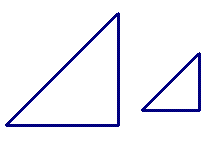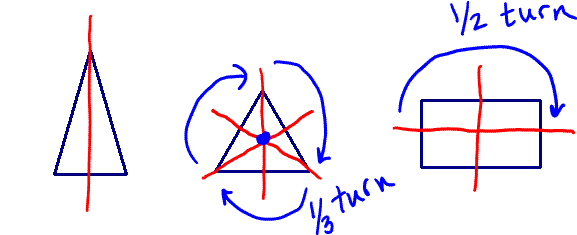Saturday, Jan 30, we did:
Discussed properties of shapes, with emphasis on special triangles:
Properties of shapes are also called
attributes: specific things that are true about shapes
Examples are:
Similar: the shapes are the
same shape (including having the same angles) but may be different
sizes.
These triangles are similar:

: the shapes are the
same shape and the same size, though one can be flipped or turned when
compared to the other.
Number of sides
|
Size
of angle
|
|
When describing an angle
|
|
When describing a triangle
|
| Less than 90° |
acute
|
all 3 angles are acute
|
| greater than 90° |
obtuse
|
one angle is obtuse
|
| exactly 90° |
right
|
one angle is right
|
Length of sides:
isosceles
triangle: at least two sides are the same length
equilateral triangle: all 3
sides are the same length
scalene triangle: all 3 sides
are different lengths
Added later:
Symmetric
Has line symmetry (also called
reflection symmetry)
Has rotational symmetry
Every triangle is either acute, obtuse or right; every triangle is
either isosceles or scalene
This file
includes an example of each of the combinations of angle and side
length properties that are possible. There are 7 triangles.
Cut them out, and tape them into a table like this:
|
acute
|
right
|
obtuse
|
isosceles
|
|
|
|
scalene
|
|
|
|
Check your answers here
Now, make some triangles on a geoboard; transfer them to dot paper, and
cut out a set of 10 where none of the 10 triangles are congruent (same
shape and size). Figure out which ones are isosceles. Think
about how you make isosceles triangles on a geoboard. Verify that
you don't have any triangles that are equilateral (you can get pretty
close, but not exactly equilateral). See here for more info on
the activity.
Next, we discussed 3 important ideas for teacher standard 6, and how
they fit into the activities we had done so far. The big ideas we
discussed were:
Communication
(verbal and non-verbal: non verbal communication means things
like showing diagrams and pictures and modeling what to do, it doesn't
mean that you have to not talk)
Collaboration (where you or
students work together or discuss together to complete the task)
Inquiry (where part of what
you are doing is discovering something/figuring something out)
Here's the
class discussion
We looked at the sheet of very symmetric capital letters, and we used
it to discuss symmetry:
Line Symmetry
|
The shape is the same (mirror
image) on both sides of a symmetry line. The line can be
horizontal, vertical or diagonal
|
Show line symmetry by drawing in
the symmetry line
|
Rotational symmetry
|
The shape is the same
after you turn it part way around (usually when you turn it upside down
it looks the same)
|
Show rotation symmetry by
drawing a dot in the center, drawing an arrow around the shape to show
how much to turn it (and keep it the same), and name how far to turn
it. In higher grades we name how to turn it by an angle in
degrees. In the lower grades, we talk about half turns and
quarter turns and 1/3 turns (because you turn it half or a quarter or a
third of the whole way around. A half turn is a turn of 180°
|
Examples:

an isosceles triangle has one
line of symmetry
|
an equilateral triangle has 3
lines of symmetry, and it has 1/3 turn rotational symmetry
|
a rectangle has 2 lines of
symmetry, and it has 1/2 turn rotational symmetry
|
Here's some of the
class discussion on
symmetry
The web site
http://www.adrianbruce.com/Symmetry/10.htm
has some pictures to help you understand rotational symmetry.
Telling the order of a symmetry is almost the same as telling the turn
size: an order 5 rotational symmetry, is also called a 1/5 turn
symmetry.
How to play:
- Get a lot of geometric shapes
- Make 2 overlapping circles (a Venn diagram)
- The rule-maker comes up with two rules: one for each
circle. Each rule has to be a property that some of the shapes
have.
- The rule maker puts at least two shapes on the diagram: one that
belongs in each circle
- The guessers ask where various shapes go on the diagram until
they start making guesses about what the rules might be. If a
guesser thinks they know the rule, then they tell the rule maker where
they think a shape should go, and the rule maker tells them if they are
correct or not.
- After all the shapes are on the diagram (some shapes belong in
circles, and some shapes belong outside both circles), then someone
guesses what they think the rule is.
Here is
our class playing the guess my
rule game
Here is a third grade class doing a very similar activity:
http://www.learner.org/courses/learningmath/geometry/session10/35video.html
